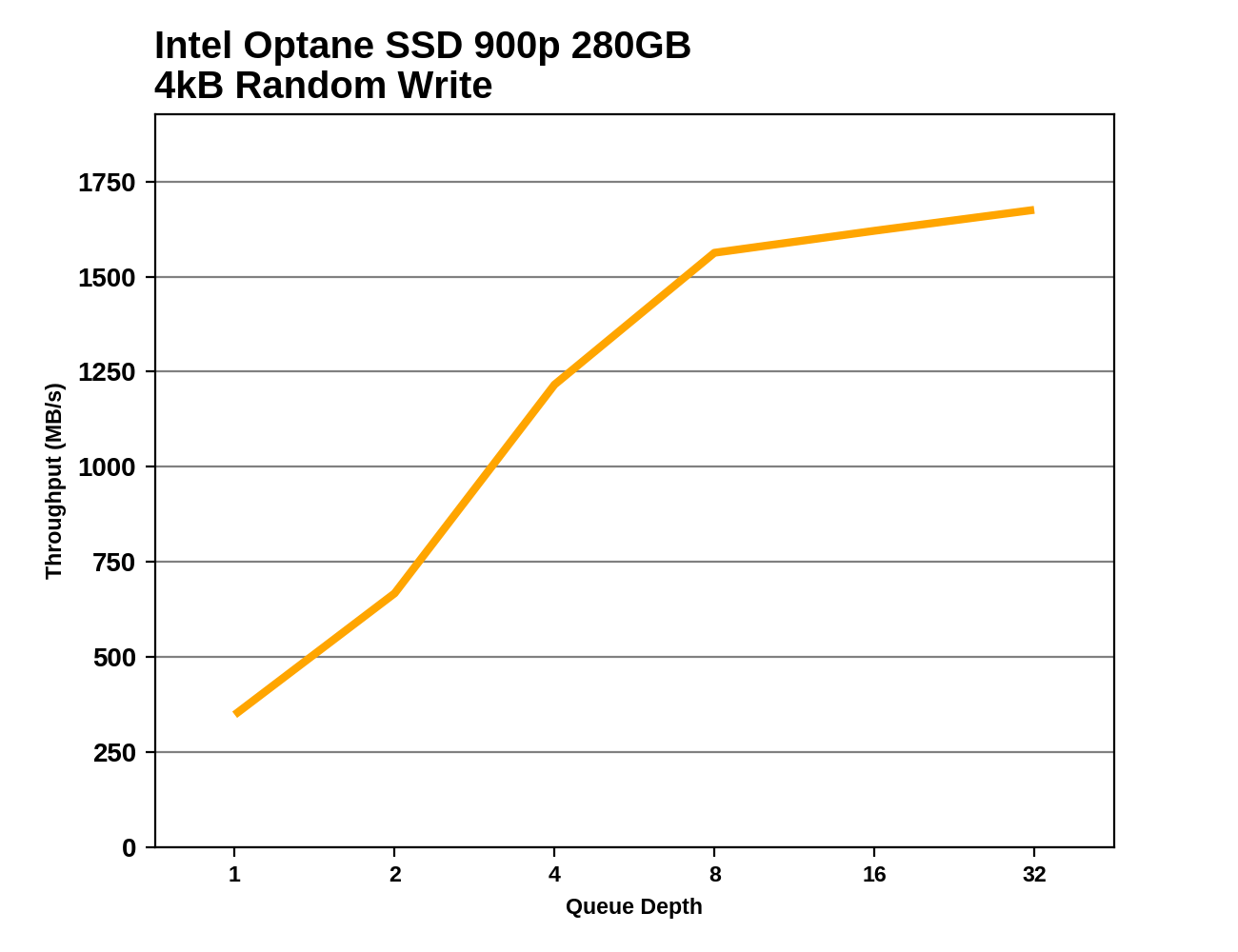The Intel Optane SSD 900P 280GB Review
by Billy Tallis on October 27, 2017 9:30 AM ESTRandom Read Performance
Our first test of random read performance uses very short bursts of operations issued one at a time with no queuing. The drives are given enough idle time between bursts to yield an overall duty cycle of 20%, so thermal throttling is impossible. Each burst consists of a total of 32MB of 4kB random reads, from a 16GB span of the disk. The total data read is 1GB.

The Optane SSD 900P doesn't break the record for QD1 random reads, but only because we've also tested the 32GB Optane Memory M.2, which is about two microseconds faster on average for each 4kB read. The Optane SSD 900P is still about 7 times faster than any flash-based SSD.
Our sustained random read performance is similar to the random read test from our 2015 test suite: queue depths from 1 to 32 are tested, and the average performance and power efficiency across QD1, QD2 and QD4 are reported as the primary scores. Each queue depth is tested for one minute or 32GB of data transferred, whichever is shorter. After each queue depth is tested, the drive is given up to one minute to cool off so that the higher queue depths are unlikely to be affected by accumulated heat build-up. The individual read operations are again 4kB, and cover a 64GB span of the drive.

When longer transfers and higher queue depths come into play, the Optane SSD 900P passes the Optane Memory M.2 and remains more than 6 times faster for random reads than any flash-based SSD.
 |
|||||||||
Both Optane devices more or less level off at queue depths of 8 or higher. The Optane SSD 900P saturates at about 1800 MB/s while the Optane Memory tops out around 1300 MB/s. The Samsung 960 PRO 2TB hasn't caught up by QD32, and doesn't surpass the QD1 random read performance of the Optane SSD until the Samsung reaches a queue depth of about 8.
Random Write Performance
Our test of random write burst performance is structured similarly to the random read burst test, but each burst is only 4MB and the total test length is 128MB. The 4kB random write operations are distributed over a 16GB span of the drive, and the operations are issued one at a time with no queuing.

The burst random write performance of the Optane SSD 900P is slightly higher than the Intel SSD 750 1.2TB, and about 14% faster than Samsung's fastest.
As with the sustained random read test, our sustained 4kB random write test runs for up to one minute or 32GB per queue depth, covering a 64GB span of the drive and giving the drive up to 1 minute of idle time between queue depths to allow for write caches to be flushed and for the drive to cool down.

With higher queue depths in play, the Optane SSD 900P scales up faster than the Intel SSD 750 1.2TB, leaving the Optane SSD with a 7-10% lead over the Samsung 960s and Intel 750.
 |
|||||||||
Samsung's 960 PROs and the larger 960 EVO all trail slightly behind the Optane SSD's random write performance for queue depths 1 to 4, then the Samsung drives level off and leave the Optane SSD with a substantial performance advantage at high queue depths. The Intel 750 is slightly faster at QD1 and QD2, but saturates at an even lower performance level than the Samsung 960s.










205 Comments
View All Comments
Lolimaster - Saturday, October 28, 2017 - link
Optane seems like a Joke not only in endurance, performance, but not power consumption too. Right now it's basically a bot for random 4K, you don't really need that, get the 960EVO/PRO.Lolimaster - Saturday, October 28, 2017 - link
*now.AnnonymousCoward - Saturday, October 28, 2017 - link
Why are you saying get the 960 PRO? It costs double a normal SSD and performs the same in real-world. Please enlighten me.SunnyNW - Saturday, October 28, 2017 - link
Would system start-up be any faster?Lolimaster - Saturday, October 28, 2017 - link
Probably yes since it has higher random 4k read and latency. Wanna check the limit, search those old ramdisk booting times. Above that we would need a boot disk of L3 cache memory class, then one made up of L2 cache memory class, edram, etc.Lolimaster - Saturday, October 28, 2017 - link
Till you reach L1 cache memory class or sram."Bullwinkle J Moose" - Saturday, October 28, 2017 - link
That depends....How fast is Fast?
I've seen people bragging on youtube that their new 90+ Watt Quadcore Intel CPU will boot Win 10 to an M.2 EVO drive in 17-20 seconds....
But my 35 Watt dualcore Sandy bridge will boot Windows 10 Fall Crappers Edition (Sept 2017) to an 850 Pro in 5.35 seconds.....
or, the same machine will boot Windows XP-SP2 to the same 850 Pro in 3 - 4 seconds (Varies sleightly every boot)
So, how fast is fast?
jabber - Saturday, October 28, 2017 - link
Good luck to the couple of dozen or so that will be able to make proper use of this and notice a difference over a 850 EVO .Pork@III - Saturday, October 28, 2017 - link
Do fast? Yes it is fast. Has volume? - Nope.I maked install of operation system and come to install FM7 on 128GB SSD and instalator say me: "not enough space". :(
nOOky - Saturday, October 28, 2017 - link
The 280 gig drive is priced similarly to the Samsung 830 Pro 256 gig when it came out if you're thinking the price is outrageous...